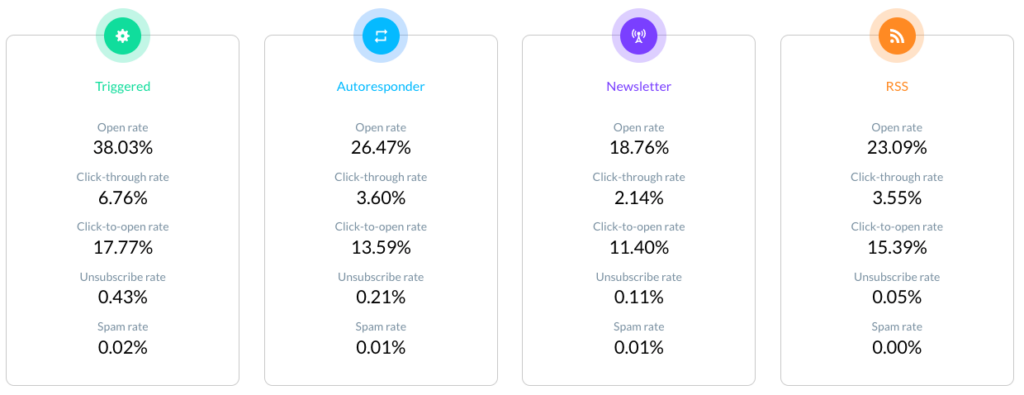Triggered Email Messages That Every Service Business Needs to Use

On the most basic level, triggered emails are one-on-one emails sent to individuals in response to specific actions.
In contrast with generic emails, triggered emails are timely, relevant, and customized not just with fill-ins like the recipient’s name, but according to the recipient’s actions and recent interest, including personalized subject lines.
That being the case, it’s not surprising that triggered emails have a higher open rate and click-through rate. After all, they’re a lot more interesting for the person receiving them.
According to GetResponse’s research, open rates, click-through rates, and click to reopen rates are all higher for triggered emails than for autoresponder emails, newsletter emails, or RSS emails.

Like everything that’s worth achieving, triggered emails aren’t easy. You need to set up an integrated marketing data and analytics system that can spot the right time to send the right email to the right individual.
What’s more, in contrast with eCommerce businesses, service-based businesses often encompass non-digital touchpoints, making it harder to consolidate all the required signals and to set up the triggers that are most important to your customer experience. But the conversion rates you’ll see if you do it well certainly make it worth the time and effort.
Here are nine triggered emails that service businesses need to have set up in 2022.
1. Funnel interruption emails
Abandoned cart emails are pretty common for eCommerce businesses to remind users who bail out before completing an order, but service businesses can and should leverage the same tactic. Your customers may not be after physical products, but they do select and book services.
Send a triggered email when a visitor to your website chooses a date and time for their appointment but doesn’t click “confirm;” enters their email address to open an account and examines the different packages you offer, but hasn’t made a purchase; or buys a bundled package of services, but doesn’t get as far as scheduling an appointment.
Make sure that your email mentions the specific products or lines of service they were interested in, to make it as personalized as possible.
If the recipient already selected a date and time but didn’t confirm it, include a reminder of the time slot they were considering and a link to confirm it in one click. Email platforms like GetResponse connect with your website to create workflows that spot an unfinished process and trigger this kind of transactional email.
2. Confirmation emails
Confirmation emails are the most obvious kind of triggered email, but somehow they are often the easiest to overlook.
Set up a process that sends your client a short, sweet note that thanks them for making an appointment and recaps their appointment details.
Ideally, you should also include a link that adds the appointment to their Google or iCal calendar, making it all a seamless process that removes friction for the customer.
3. Reminder emails
As well as the confirmation email and calendar link, it’s a good idea to send a reminder email shortly before the appointment, so that users don’t miss their long-awaited slot. People have busy lives, so they generally appreciate a heads up that helps them make the facial, yoga class or dog grooming slot they’ve been looking forward to.
It’s important to select the right interval before the appointment, which could be anything from an hour before to the previous day or the beginning of the week of the appointment. It all depends on what service you offer, how long the appointment is, and how far in advance they booked. You might even send two reminders, one at the beginning of the week and one on the morning of the appointment.

You can do this easily with vcita, which automates reminders by email and SMS, and comes pre-integrated with the platform’s CRM, payments solutions, and appointment booking engine. Set the intervals you want to use for reminders, and vcita will send them using the recipient’s name and reminding them about the exact service they’ve booked.
4. Follow up emails
Customer relationships don’t end when the appointment does. Maintain your connection and add to the value you provide for clients by sending useful content that guides them to keep up their look, health, finances, home decor, etc. in between appointments.
You might also want to recap some of the information and/or techniques that you shared during your session and remind clients to use them at the right intervals.
For example, a yoga teacher might send a reminder the day after class, reminding you to do some basic stretches she showed you; a bookkeeper might send a reminder the following month to download and save your statement ready for the next quarter’s tax return; a beautician might send tips for keeping your skin looking fresh in-between facials, etc.
5. Appointment change or cancellation emails
If there’s any triggered email that’s 100% vital, it’s this one. Life happens, and your customers know and understand that, but they won’t forgive you for keeping them in the dark when it does. You need to send an email any time that the time, date, location, or any other condition of the client’s appointment has to be changed, or if you need to cancel it and ask them to reschedule.
In your triggered email, make sure to include a link to your online calendar, so they can easily reschedule, confirm your suggested new time/date/location/etc, or cancel the appointment and schedule a new one. When you use vcita, the system embeds a link in the body of the email.
6. Thank you emails
It’s polite and good business practice to say a simple but heartfelt “thank you” after the client attended their appointment, especially if this was their first appointment with your business.
What’s more, you can take the opportunity to remind them to book a follow-up appointment at the right interval, so a dentist could send a reminder to book an appointment at the hygienist after someone’s had a check up, or a massage therapist could recommend booking the next appointment in a month so the stress knots don’t get too tight.

Above is a great example of a “thank you for a great year together” type of email that a Massachusets based-spa sends to each customer to celebrate the anniversary of the relationship. The discount-focused call-to action is an especially nice touch.
7. Unpaid invoice reminders
Nobody likes chasing payments, but it has to be done sometimes. When you set triggered emails for this purpose, it’ll save you from tearing your hair out searching for the right firm-yet-kind wording every time.
Include details about the payment, such as the amount, what it’s for, the date you first sent the payment request, etc., together with a link to make it easy for them to pay.
QuickBooks has an easy-to-set-up process where you can write content for different reminder emails and set the conditions that trigger one being sent. This way, you can begin with a light tone and get more severe as more time passes, because the emails are triggered by how long it’s been since the invoice was sent.
8. Reactivation emails
Reactivation emails aren’t just for lapsed clients who haven’t been seen for months, but also whenever it’s verging on too long between appointments.
It’s important that your reactivation reminder is appropriately timed: send it too soon, and the client feels nagged and pestered, but if you wait too long, they might need more or longer sessions to correct the damage to their hair, skin, business accounts, bad back, etc.
There’s no fixed recipe for how long to wait before sending a reminder email, but some things to consider include:
- Your service. Pedicure clients might come every 4-6 weeks, for example, but facial clients every 3-4 weeks.
- The time of year. Lawn care clients might go 4-5 months between appointments in winter, but only 6 weeks in summer.
- The specific client. Hair stylists may send a reminder to a client with short hair after 6 weeks, but wait 10 weeks before emailing someone with long hair.
9. Special event offer emails
These special offers are more tailored than a standard or seasonal discount offer, because they’re personalized according to some significant date in the life of the recipient.
It’s up to you what that is — it could be the anniversary of the date the client first signed up to your business or had their first appointment, or the client’s birthday or wedding anniversary.
Most email platforms like GetResponse, ConstantContact, vcita, and more include this ability, as long as you integrate them with your CRM. It’s worth remembering that vcita is already integrated with your CRM by default, so the process is shorter.
Triggered Emails Can Propel Your Service Business Forwards
Emails might seem old-fashioned, but it’s a mistake to overlook them. As you can see, triggered emails have more uses than you might realize for service businesses, ranging from encouraging people to book their first appointments to bringing them back for more and ensuring they stay on top of their new regimens.
The right arsenal of triggered emails and power your business to renewed growth.
